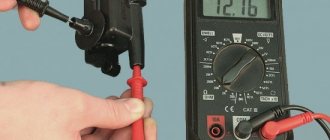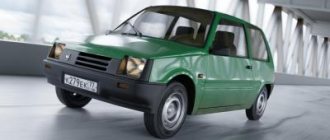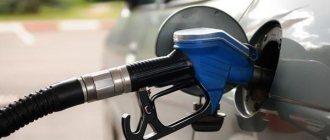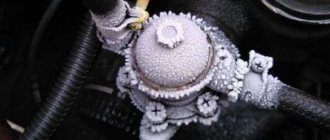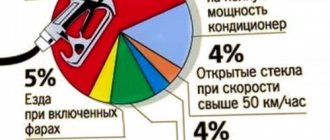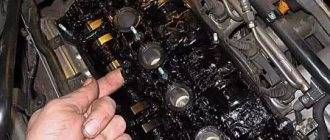Vehicle Data
Lancer IX of 2005 of release, it is bought in 2006. The mileage is 140,000 km. Engine capacity 1.6 CAT: MT. Brains are chipped. The second lambda is disabled. Catalysts in place. Wheels 15 radius. Gasoline 92. Season of measurements: summer.
Passport data:
City: 9 l / 100km Combined cycle: 6.8 l / 100 km Course: 5.5 l / 100km
Own observations:
City:
– the maximum indicator with a dynamic driving (up to 4 thousand revolutions of the engine): 8.5 l / 100 km. – the minimum indicator for a smooth ride (up to 2.5-3 thousand motor revolutions): 7.5 l / 100 km.
*
When using 95 gasoline, the flow rate is less by 1 — 1.2 l / 100 km.
At the minimal expense it is necessary to understand, that it is necessary to observe it to observe several points: 1. Very smooth manner of dispersal. Pressing the accelerator pedal is done no deeper than 2×3 cm. 2. Smooth braking. Without the need to not press the brake pedal, brake only the engine.
As correctly noted in the comments, this ride is called “walk faster” or “ride like a grandfather.”
With all of the above, I practically do not stand at traffic lights. I switch to a lower one in advance, so that by the time the car arrives at the traffic light, it has already lighted up green. If you want to achieve minimum performance, you need to achieve the maximum efficiency of the engine.
Combined Cycle:
– the maximum is 7.4 l / 100 km.
*
When using 95 gasoline, the flow rate is 6.4 l / 100 km.
Track:
– fully loaded passengers, 3pcs + driver, average speed 120 km/h, all the time running climate control, the M4 route — 6.4 l/100km.
*
Similar conditions, but on 95 gasoline the expense of 5.4 l / 100km.
All measurements were made as follows: I reset the day run counter, refuel “to full”, I drive in the appropriate mode until the low fuel indicator lights up, refuel again “to the full” (about 40-45 liters), and I think the expense is based on the mileage and count of the gasoline filled into the tank. Refueling at the same gas station, on the same column.
Engine Brain Chip
Chip does not give a reduction in consumption, it only gives more options for the mixture, which is prepared for supply to the engine. If the standard firmware lancer has only 3 versions of the mixture: 1. Lonely. 2. Average. 3. Enriched.
JUST HUGE GASOLINE CONSUMPTION
Moderators: mek, indy
JUST HUGE GASOLINE CONSUMPTION
#1 Post by ASRaceR » 25 Nov 2007, 19:44
On my Lancer Cedia 1.5, from the moment of purchase (10 months), the fuel consumption in the city was 10-11 liters, on the highway up to 120 about 7-8 liters, 140 and > about 11. And just a month ago the Lancer became eat like a tractor. on the highway up to 120 km/h 14 liters of 92 gasoline. The air filter is new, the spark plugs were changed a month ago, the throttle is clean, the filter in the injection pump is clean, it starts great in any weather. It feels like the dynamics have worsened, the engine has started to make a lot of noise when accelerating, and sometimes the hydraulics still make a knocking noise at idle. And also, warm up the car at idle to 90 degrees. Not possible at all, even for 10 minutes. at least 20 min. warm it up only after you have driven a few km. it warms up.
Tell me what to do to get rid of such a huge expense.
And in general, what should be the normal consumption for this car?
Good day, friends! If you are the owner of a Mitsubishi Lancer 9, then spend a few minutes studying this material - it is quite possible that it will be useful to you. Precisely because Lancer 9 fuel consumption is the topic of our discussion today.
Reasons for increased gasoline consumption
Not a single service station technician will tell you why gasoline is being wasted without preliminary diagnostics. The problem may lie in the internal combustion engine itself, or in the fuel supply system, injector, carburetor (9th Lancers can have one of two power systems).
Often, owners simply operate engines incorrectly, which leads to increased consumption:
- constant stops in the city, sudden starts,
- intensive acceleration when overtaking,
- driving at consistently high speeds, using winter tires in the warm season (and vice versa),
- deflated wheels,
- untimely replacement of oil and other consumables - this causes increased fuel consumption.
Technical problems faced by Mitsubishi Lancer 9 owners:
- Clogged injectors, which leads to incorrect injection. The solution is to clean them or replace them.
- Incorrect operation of the fuel pump, due to which the pressure in the fuel system “jumps”. This results in an incorrectly proportioned fuel-air mixture.
- Exhaust gas recirculation (EGR) valve clogged. Through it, part of the exhaust gases is returned back to the engine, and this operation is controlled by the ECU, which opens and closes the valve. Over time, soot accumulates on it, and this leads to jamming of the valve. Then, during the entire operating time, a “porridge” of air, exhaust gases, and gasoline enters the combustion chamber - such a mixture is ineffective, and this leads to increased consumption. The solution is to clean the valve from burning and soot. This operation is even prescribed in the technical passport for some cars as a mandatory maintenance measure.
- Oil of incorrect viscosity or poor quality, which leads to increased friction between the pistons and cylinder walls.
- Oxygen sensor (lambda probe). Some Lancer owners overcome overspending only after replacing the lambda probe. This sensor determines the amount of oxygen in the exhaust and, based on this information, the ECU optimizes the mixture composition, supplying more or less fuel to the cylinders. Incorrect operation of the oxygen sensor increases the “appetite” of the engine.
In fact, there are many more reasons, and sometimes a whole complex of problems leads to increased consumption.
Mitsubishi Lancer 9 is not the most economical car. They received efficient and reliable engines with a service life of 250+ thousand kilometers, but they cannot be praised for their record low “appetite”.
December 17th, 2014 Admin
For 40 years now, the Japanese company Mitsubishi has been producing the Mitsubishi Lancer evolution 9. The first production of the car took place in 1973 and was conceived as a mass model. In different countries, during this time, the car was called differently: Mitsubishi Libero and Galant Fortis and Eagle Summit, etc. Naturally, since then there have been many releases of different generations, but we will focus on the currently popular Mitsubishi Lancer 9th generation. The first cars of this generation began to be sold in Japan in 2000 under the name Cedia and were offered in two body versions - sedan and station wagon. In 2003, the restyled Lancer 9 appeared on European markets, also in sedan and station wagon body styles, but in a more aggressive form, it had a different front design: double radiator trim, length 4535 mm and width 1715 mm (excluding side mirrors) .
Dimensions of Mitsubishi Lancer 9:
mitsubishi lancer 9 technical specifications, ground clearance of mitsubishi lancer 9
Compared with its predecessor, the height of the Lancer 9 sedan has increased
at 50 mm it
is now 1445 mm
,
the width
has increased
to 1715 mm
.
Legroom for passengers has also increased by 60 mm. Mitsubishi Lancer station wagon dimensions: height – 1450, length – 4485, width 1695. In both the sedan and station wagon, the ground clearance
of the Mitsubishi Lancer 9 is
165 mm
, the wheelbase is 2600 mm.
How much does the most common version of Lancer “eat”?
This car model, especially in the 1.6 liter engine version, is one of the quite common ones on domestic roads. But, let us immediately note that the machine is considered to be quite picky about the quality of fuel. To increase the service life of the engine, you should fill it with proven gasoline. By the way, this also affects the Lancer’s fuel consumption per 100 km. Drivers who previously refueled exclusively with grade 98 often later complained of symptoms of engine overheating.
If the engine itself is functioning properly, then the consumption rate remains within the factory recommended values. However, it’s not in vain that we decided to write today’s review. In practice, even owners of such low-power engines experience high consumption, sometimes reaching 15 liters for every 100 kilometers traveled. One of the main factors may be a faulty catalyst. It is unlikely that it will help to remove the old faulty part, but rather you will have to purchase a new one to replace it. Due to deposits, the catalyst fails - this is the quality of domestic gasoline. And along with it, you will have to replace the spark plugs along the way.
see also
Comments 36
Do you change the filter once every km? At every oil change I change the oil, air and cabin air. Those. once every 15,000. But after 10,000 I lose oil, I’m thinking of reducing the interval to 10,000
You rarely change the oil, you can ruin the engine. I change it in spring and autumn, respectively, for winter and summer oil. It turns out to be about 7 thousand km. And the oil consumes 100 grams from change to change, that is, I don’t add it. And air and cabin filters once a year
Who told you that replacing every 15,000 will ruin the engine?
I said my opinion, you don’t have to change it at all, I don’t care
You rarely change the oil, you can ruin the engine. I change it in spring and autumn, respectively, for winter and summer oil. It turns out to be about 7 thousand km. And the oil consumes 100 grams from change to change, that is, I don’t add it. And air and cabin filters once a year
I agree, it works out pretty much the same way for me...
Do you change the filter once every km? At every oil change I change the oil, air and cabin air. Those. once every 15,000. But after 10,000 I lose oil, I’m thinking of reducing the interval to 10,000
15,000 km. This is a lot of oil; I have never changed it so rarely on any car. Well, it also depends on what kind of mileage: in the city, mixed or on the highway. And what kind of oil is poured - synthetic or semi-synthetic. I change filters about twice a year or after the second oil change, whichever comes first.
It's very harmful because... For example, because we have bad fuel. But I drive on gas. Or because there is a lot of dust and it gets into the engine. But I always change the oil and filter with an oil change. Or because the car is always under load? Yes, a little bit. Most of my driving around the city is in start-stop mode with a lot of stops. I'm just interested in hearing specific arguments)
Automatic transmission and 2-liter version are his appetites
The situation is also disappointing with the automatic transmission. You can safely add 1.5–2 liters to reach real values. Some owners note the appetites of their Lancer, reaching up to 15 liters! The 2.0 liter version of the Japanese car is even capable of bankrupting the owner. Fuel consumption is up to 13 liters, based solely on the car’s passport data. On the highway the car consumes less, up to about 8.5–8.6 liters.
In many ways, the consumption component, in other words, the car’s gluttony, is influenced by the driving method that the driver prefers. Some are reckless and start from a standstill, and what kind of consumption can you expect in this case? Yes, yes to very high)
And now the data provided by the manufacturer.
| Engine and transmission | Fuel consumption in the urban cycle, l/100km | Fuel consumption in the extra-urban cycle, l/100km | Fuel consumption in the combined cycle, l/100km |
| 1.3 (82 hp) manual transmission | 8,5 | 5,3 | 6,5 |
| 1.6 (98 hp) manual transmission | 8,8 | 5,5 | 6,7 |
| 1.6 (98 hp) automatic transmission | 10,3 | 4,4 | 7,9 |
| 2.0 (135 hp) manual transmission | 11,7 | 8,4 | 6,5 |
| 2.0 (135 hp) automatic transmission | 12,6 | 9 | 6,9 |
Mitsubishi Lancer 9th generation
The 9th generation Lancers rolled off the assembly line from 2003 to 2009 and were available in sedan and station wagon bodies. Although the Cedia model, which has been sold since 2000, is also considered to be a ninth-generation car. The engine line was represented by gasoline engines of 1.3 liters (69 hp), 1.6 liters (120 and 124 hp) and 2.0 liters (170 hp). In North America, cars with 2.4 liter engines (164 hp) were popular.
Reviews of the real consumption of Mitsubishi Lancer IX
- Anatoly, Moscow. I purchased a ninth generation Mitsubishi Lancer 2004 with a 1.5 liter engine. Of course, this sedan is far from a sports car, and the engine power is not for high speeds. But 6-7 liters of gasoline per hundred kilometers is a very economical option.
- Sergey, St. Petersburg. I bought a car from the second owner, I had to work on it, but only a little, because Mitsubishi is a very high-quality equipment. The mechanical component is excellent. On good roads it consumes about 6-6.5 liters per hundred, even with air conditioning. Model 2007, 1.6, manual.
- Artem, N. Novgorod. Mitsubishi Lancer 2003, 1.5, manual. Before him, I drove a liter Matiz. Of course, these are completely different cars in terms of reliability, dynamics, and comfort. But they have one thing in common - consumption is from 5 to 7 liters. But the Lancer only needs 95 gasoline.
- Alexey, Saratov. My Mitsubishi Lancer has a 1.8 liter CVT engine. Of course, the power is at the level, and it accelerates without strain. If I drive alone, I spend about 11 liters in the city, but when four passengers are seated, it already goes up to 13-14 liters. It seems to me that this is too much.
- Boris, Omsk. I am the owner of a Mitsubishi Lancer 1.6, automatic transmission, 2008 model. When traveling long distances, I specifically measure fuel consumption. At a speed of 80-90 km/h it takes about 6.5 liters. The higher the speed, the higher the consumption. In the city it reaches 11 liters.
- Bogdan, Tula. Since I often have to travel around the country on business trips, I decided to buy a car. The criteria were: power, reliability, economical consumption. Mitsubishi Lancer of the ninth generation 2008 with a 1.8 engine came just in time. Within 100 km/h, about 9-10 liters are consumed, up to 150 km/h consumption increases to 14 liters.
- Stepan, Tambov. My Mitsubishi Lancer is equipped with a 1.6 liter engine paired with an automatic transmission. This car can rightfully be called a city car. Its consumption is very economical - on the highway 6-7 liters, in the city up to 10 liters of gasoline. Air conditioning and driving in traffic jams increase consumption just a little.
How much does the subcompact version consume?
If you are one of those who prefer to save on servicing a Lancer, purchase a modest and low-power 1.3 liter version with an engine of just 83 horsepower. Statistics for this configuration indicate that, according to official data, again, a car with such an engine should “eat” a maximum of 8.6 liters. Having turned to the owners for feedback, we find that in reality it comes out to 9.63 when driving around the city. If you have your own excellent data, write to us.
With this we will say goodbye, friends. There are many other useful discussions ahead of us regarding fuel consumption of other car brands, and not only. Subscribe to the blog and stay up to date with events. Bye!
Mitsubishi Lancer 8th generation
The 8th generation Mitsubishi Lancer was produced from 1996 to 2003. Cars of this generation were available in sedan body type, and sometimes coupes were also available. For consumers in European countries, configurations with gasoline engines of 1.3 liters (power 69 hp) and 1.6 liters (power 120 and 124 hp) were offered.
Reviews of the real consumption of Mitsubishi Lancer VIII
- Ruslan, Makhachkala. I bought a 2003 Mitsubishi Lancer, 1.6 liter engine. Despite the small volume, I am completely satisfied with the car, because I am not a fan of driving. And for a calm, measured ride it is quite enough. Even the fact that I didn’t buy it new did not in any way affect its driving performance. Consumption for a sedan is quite normal - up to 10 liters.
- Igor, Yaroslavl. At the time of choosing a car, I did not expect more than a budget option. And the 2001 Mitsubishi Lancer fits perfectly into my calculations. The fact that the year of manufacture is old does not harm the car. Good ride, dynamics, comfortable fit. Ten liters of gasoline are enough for 170-180 km. Engine 1.6 l.
- Oleg, Syzran. I have a 2002 Mitsubishi Lancer, 1.6 liter engine, automatic transmission. The car is decent, but there are a lot of shortcomings. Sometimes it jerks when changing gears, the power is not enough for me. But fuel consumption is quite economical, at low speeds about 6 liters.
- Vladislav, Perm. My father gave me a 2000 Mitsubishi Lancer, 1.3 liter. Everyone already knows about the qualities of the “Japanese”; I measured fuel consumption. On good roads, consumption is around 6-6.5 liters, unfortunately, there are few of them. On normal roads it takes up to 10-11 liters of gasoline.
- Vladimir, Kostroma. I bought the 2001 Mitsubishi Lancer new, and now I have driven more than 270 thousand km. So far it is undergoing routine scheduled maintenance; nothing else has been done to the car. Reliable, unbreakable, unpretentious machine. Fuel consumption is about 8-9 liters on average. Engine 1.3 l.
- Andrey, Irkutsk . Before the Mitsubishi Lancer, I had a two-liter Honda Civic. Of course, there is a difference, but the power of the 1.6-liter Lancer is quite enough for me. It behaves well on the road and does not consume much - from 8 liters outside the city to 11-12 liters in the city. Model 1999 release.
- Gregory, Vologda. I've been driving a Mitsubishi Lancer 2000 for five years now. During all this time I hardly climbed under the hood. Consumables and oil - that's all the replacement. The car is indestructible, drives in any weather. In the city I consume up to 12 liters, on the highway 6-8 liters, depending on the quality of the road surface.
